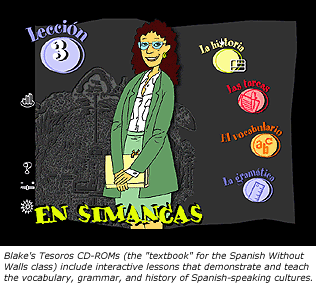|
|
Spanish Without Walls
Using Technology to Teach Language Anywhere
|
|
|
|
Spanish Without Walls
Using Technology to Teach Language Anywhere
|
|
|
Power shortages aside, these are challenging times for the Golden State. As California continues to be a melting pot of many cultures and languages, government agencies are struggling to meet the needs of an ever-growing and increasingly diverse population. These issues are mirrored in the state's university system, as schools struggle to find classrooms and other teaching facilities to accommodate nearly unprecedented student population growth. This space and resource crunch has prompted universities to explore new ideas and techniques to continue providing a high quality educational experience. 
The Project
In collaboration with Dr. Maria Victoria Gonzalez Pagani of UC Santa Cruz, Blake recently began developing a university-level Spanish language course that will be taught completely outside of the classroom. Offered in the fall through University Extension, students in the course will utilize a series of interactive CD-ROMs and a database-driven Web site to practice their language skills, complete assignments and exams, and even interact with classmates and professors in real-time. The project, dubbed Spanish Without Walls, is unique in that previous distance learning efforts have focused primarily on the physical sciences and not language learning. "Learning a language with the assistance of a computer may seem a little counter-intuitive to some people," Blake shares. "However, the sound and video capabilities inherent in today's computers, along with the Web, actually offer great potential to students for an enriched understanding of new languages, dialects and cultures." Others must agree, as a three-year $230,000 grant was awarded last year to Blake and Pagani for Spanish Without Walls by the Department of Education's Fund for Improvement of Post-Secondary Education (FIPSE). Background
Dr. Blake, a professor in the Department of Spanish & Classics, has long been involved in expanding the role of technology in second language learning. "As 1984 brought the Apple Macintosh to the world," Blake says," I quickly discovered that a visual interface was ideal for language learning." The author of many published journal articles on using technology to facilitate Spanish teaching, Blake has also helped create two CD-ROM series (Nuevos Destinos [New Destinies] in 1998 and Tesoros [Treasures] in 2000) that utilized the rich capability of multimedia to dynamically demonstrate and teach the Spanish language and culture.During this time, Blake began to collaborate with Pagani, who had previously developed a series of language-oriented courses at UC Santa Cruz, all of which were entirely Web-based. Together, they sought ways that technology could provide solutions for the budgetary and space crunch many UC language departments are facing. "There are many professors scattered throughout the UC system with world-class expertise in a host of languages," shares Blake. "However, most schools individually are unable to support an extremely diverse language program. We looked to technology and the Internet for solutions." From these discussions came the ideas for Spanish Without Walls. Leveraging Technology to Create the Virtual Classroom
Utilizing the funds from the FIPSE grant, Blake and Pagani have begun development of the database for the Web site, which will include a wealth of Spanish-language learning resources, including Pagani's Web-based courses, a complete Spanish dictionary, and verb conjugation library. A key element of the site will also be a live connection to a university-developed chat program that will allow students to interact with instructors and other learners. Serving as the "textbook" for the language course will be Blake's recently published Tesoros CD-ROM. A five-CD set for both Macintosh and PC compatibles, Tesoros leads students on an interactive journey through all 21 Spanish-speaking countries. Utilizing the computer's multimedia capabilities, the CDs also enable students to hear the many different dialects of the Spanish-speaking world and watch short videos on each country's culture and geography. "An important element of language learning is being able to hear the language spoken in its native setting," Blake says. "Using a computer's built-in sound capabilities, we are able to provide the students with this valuable experience. They can then also hear a specific dialect over and over, learning its nuances without feeling pressured or self conscious." Looking Toward the Future
Blake and Pagani plan to test the effectiveness of Spanish Without Walls in Spring 2002 by comparing the language competency test results of students participating in the program beginning this fall with students taking introductory Spanish in a traditional classroom setting. If the test results are similar, both hope to eventually expand the Spanish Without Walls program to include the entire UC system. Blake also sees much larger possibilities on the horizon. "Though the current project focuses on the Spanish language, future iterations can serve as a model for effective language learning of most any world language, including English," Blake says. "If we can create a model for effectively teaching language at a distance, language professors from every campus can utilize this technology to create a UC-wide language learning series of incredible flexibility and diversity. Students from any UC campus would then be able to access the language knowledge and expertise of the entire UC system, and each university could then focus its resources on supporting a more robust and highly specialized language program. When using the proper technology and a clear model, the sky's the limit." |
|
|